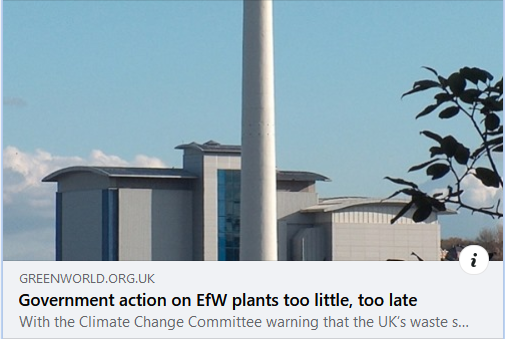greenworld.org.uk/article/government-action-efw-plants-too-little-too-late
New incinerators threaten to add up to 10 million tonnes of carbon dioxide equivalent emissions per year in the UK - yet the North London Waste Authority, with the support of all the boroughs involved, insists that its Edmonton vanity project is environmentally friendly.
Evidence, if we needed any, that Energy From Waste (ie incinerators) is reducing the likelihood of curbing greenhouse emissions comes from the government's own official Climate Change Commission:
“If EfW plants under construction and granted planning approval in the UK were all built, and plant utilisation rates remained unchanged, this would add 3-10 MtCO2e/year to UK emissions. To prevent this major increase, either a substantial fraction – potentially a majority – of the EfW plant pipeline will have to remain unbuilt, EfW fleet utilisation rates will have to fall, or else carbon capture and storage (CCS) will need to be installed on plants from the mid/late-2020s onwards to mitigate the additional emissions.”
What Jenny Jones, a Green member of the House of Lords, is saying here applies totally to the Edmonton incinerator - its existence will distort the entire waste policy in north London, either that or it will simply be abandoned, having cost councils a fortune.
"Along with incinerators comes a whole contractual arrangement that binds local authorities into a climate-damaging system of providing the fuel (the packaging and things we throw away) that makes these polluting towers financially viable. As local authorities have rapidly reduced the amount of waste they send to landfill, most of them have diverted their lorries to carry the waste for burning instead.
"A whole new generation of EfW plants is in the planning system, yet the amount of residual waste going to landfill, or being exported, has declined to the point where there won’t be enough to fuel the fires. The result of doubling our capacity to burn waste will be financial pressures to find new sources of waste, and that means either importing the stuff or reducing the amount that is recycled."
